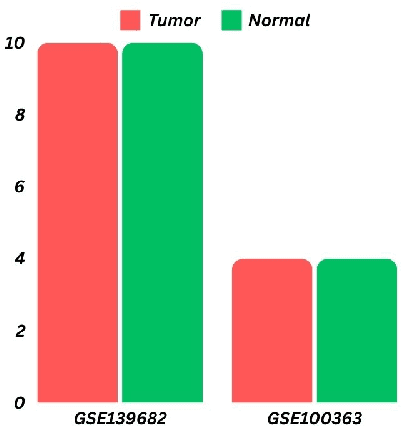Wahia Tasnim
A Bioinformatic Approach Validated Utilizing Machine Learning Algorithms to Identify Relevant Biomarkers and Crucial Pathways in Gallbladder Cancer
Oct 18, 2024



Abstract:Gallbladder cancer (GBC) is the most frequent cause of disease among biliary tract neoplasms. Identifying the molecular mechanisms and biomarkers linked to GBC progression has been a significant challenge in scientific research. Few recent studies have explored the roles of biomarkers in GBC. Our study aimed to identify biomarkers in GBC using machine learning (ML) and bioinformatics techniques. We compared GBC tumor samples with normal samples to identify differentially expressed genes (DEGs) from two microarray datasets (GSE100363, GSE139682) obtained from the NCBI GEO database. A total of 146 DEGs were found, with 39 up-regulated and 107 down-regulated genes. Functional enrichment analysis of these DEGs was performed using Gene Ontology (GO) terms and REACTOME pathways through DAVID. The protein-protein interaction network was constructed using the STRING database. To identify hub genes, we applied three ranking algorithms: Degree, MNC, and Closeness Centrality. The intersection of hub genes from these algorithms yielded 11 hub genes. Simultaneously, two feature selection methods (Pearson correlation and recursive feature elimination) were used to identify significant gene subsets. We then developed ML models using SVM and RF on the GSE100363 dataset, with validation on GSE139682, to determine the gene subset that best distinguishes GBC samples. The hub genes outperformed the other gene subsets. Finally, NTRK2, COL14A1, SCN4B, ATP1A2, SLC17A7, SLIT3, COL7A1, CLDN4, CLEC3B, ADCYAP1R1, and MFAP4 were identified as crucial genes, with SLIT3, COL7A1, and CLDN4 being strongly linked to GBC development and prediction.
Exploring Gene Regulatory Interaction Networks and predicting therapeutic molecules for Hypopharyngeal Cancer and EGFR-mutated lung adenocarcinoma
Feb 27, 2024Abstract:With the advent of Information technology, the Bioinformatics research field is becoming increasingly attractive to researchers and academicians. The recent development of various Bioinformatics toolkits has facilitated the rapid processing and analysis of vast quantities of biological data for human perception. Most studies focus on locating two connected diseases and making some observations to construct diverse gene regulatory interaction networks, a forerunner to general drug design for curing illness. For instance, Hypopharyngeal cancer is a disease that is associated with EGFR-mutated lung adenocarcinoma. In this study, we select EGFR-mutated lung adenocarcinoma and Hypopharyngeal cancer by finding the Lung metastases in hypopharyngeal cancer. To conduct this study, we collect Mircorarray datasets from GEO (Gene Expression Omnibus), an online database controlled by NCBI. Differentially expressed genes, common genes, and hub genes between the selected two diseases are detected for the succeeding move. Our research findings have suggested common therapeutic molecules for the selected diseases based on 10 hub genes with the highest interactions according to the degree topology method and the maximum clique centrality (MCC). Our suggested therapeutic molecules will be fruitful for patients with those two diseases simultaneously.
 Add to Chrome
Add to Chrome Add to Firefox
Add to Firefox Add to Edge
Add to Edge